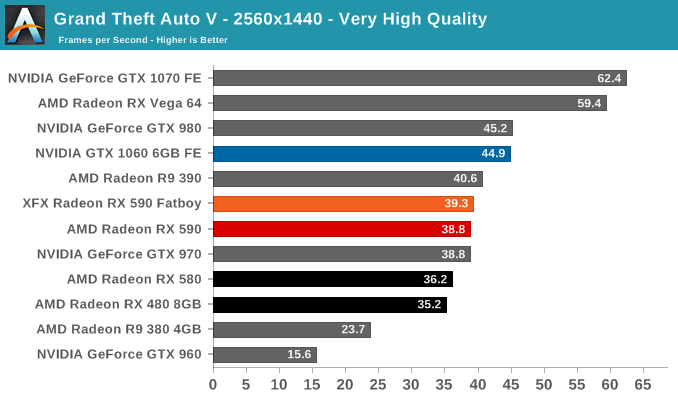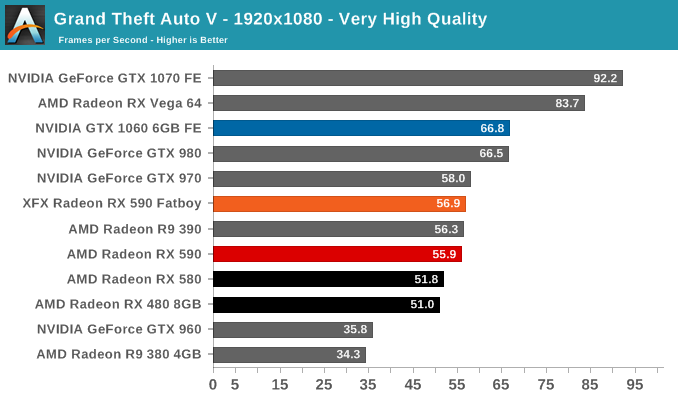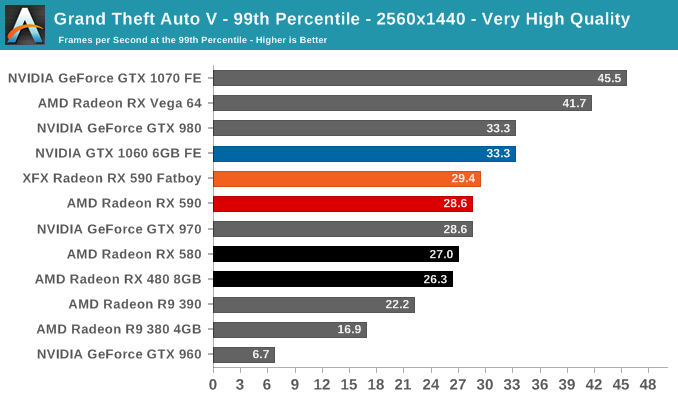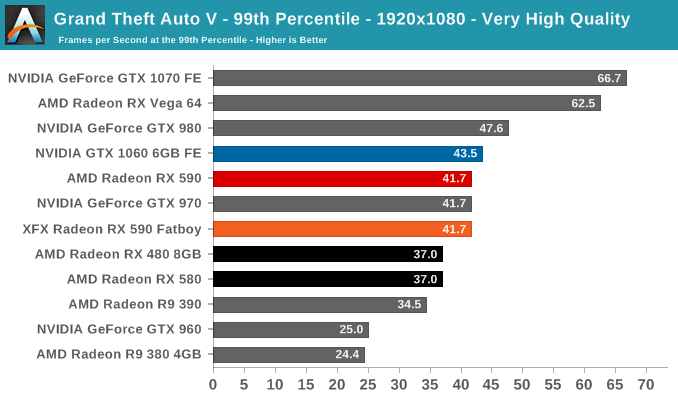The AMD Radeon RX 590 Review, feat. XFX & PowerColor: Polaris Returns (Again)
by Nate Oh on November 15, 2018 9:00 AM ESTGrand Theft Auto V (DX11)
Now a truly venerable title, GTA V is a veteran of past game suites that is still graphically demanding as they come. As an older DX11 title, it provides a glimpse into the graphically intensive games of yesteryear that don't incorporate the latest features. Originally released for consoles in 2013, the PC port came with a slew of graphical enhancements and options. Just as importantly, GTA V includes a rather intensive and informative built-in benchmark, somewhat uncommon in open-world games.
The settings are identical to its previous appearances, which are custom as GTA V does not have presets. To recap, a "Very High" quality is used, where all primary graphics settings turned up to their highest setting, except grass, which is at its own very high setting. Meanwhile 4x MSAA is enabled for direct views and reflections. This setting also involves turning on some of the advanced rendering features - the game's long shadows, high resolution shadows, and high definition flight streaming - but not increasing the view distance any further.


The ever-popular GTA V has proven itself a very demanding game even on the latest hardware, despite its age. Overall NVIDIA cards usually fare much better on it, and the GTX 1060 6GB is no exception. Polaris' best efforts across generations have narrowed the gap but isn't enough to bring it into contention against the GTX 1060 6GB. The 2GB framebuffer of the GTX 960 isn't sufficient for 1440p and falls behind the R9 380 4GB with completely unplayable performance, though at 1440p both the R9 380 4GB and the GTX 960 lack the raw horsepower to drive gameplay at that resolution anyway.













136 Comments
View All Comments
silverblue - Thursday, November 15, 2018 - link
I was talking about the process; I know the 2000 series has done well.I didn't even know TSMC had a 12nm process, but either it's not very well suited to this application or AMD have just clocked it far too highly, so it's not a successful product in that sense.
frenchy_2001 - Thursday, November 15, 2018 - link
Nvidia's Volta and Turing are fabbed on TSMC 12nm.So, it seems to work well for GPUs, but AMD's architecture is just not competitive in their perfs/watt.
silverblue - Thursday, November 15, 2018 - link
I completely forgot about them.It feels like Polaris is bottlenecked in some way, and increasing clock speeds is just a brute force way of alleviating the issue at the cost of significant power consumption. Perhaps the design is just broken to begin with.
Manch - Friday, November 16, 2018 - link
Memory bandwidth is the bottleneck for Polaris.deksman2 - Friday, November 16, 2018 - link
Power consumption - wise, its the process node from GLOFO that's limiting Polaris mainly from achieving high frequencies and low power consumption.GLOFO nodes are designed for low clocks and mobile parts... 12nmLP is designed for the same, and AMD used it for RX 590.
That's why power consumption explodes on high frequencies.
deksman2 - Friday, November 16, 2018 - link
Polaris is bottlenecked by the GLOFO 12nmLP process that's being used here.It's designed for low clocks and mobile parts.
There was NOTHING posted about AMD using TSCM 12nm node for Polaris refresh. TSMC 12nm was slated for Nvidia.
AMD gets to use TSMC 7nm high performance process node for Zen 2, Vega Instinct and Navi.
eek2121 - Saturday, November 17, 2018 - link
"Limited" is the word you want to use to describe Polaris. "Broken" would imply it doesn't work at all. Polaris was never meant to be a high end architecture. They have just been doing refreshes because they are likely reorganizing their GPU division and coming up with a new architecture to replace GCN. Doing something like that takes time, and AMD has to continue generating revenue. Also, the 590 is not a bad card at all, while I have a 1080ti in my machine, I would definitely consider a Polaris card in any new machine I build (for friends, family, etc.)deksman2 - Friday, November 16, 2018 - link
Incorrect on AMD's architecture not being competitive because AMD is still using GLOFO 12nm LP process for RX 590 which is designed for low clocks and mobile parts.TSMC 16nm and 12nm processes are designed for high performance and efficiency... those nodes are superior to GLOFO (that's why AMD's GPU's end up sucking up A LOT of power at high frequencies - its because the process node from GLOFO cannot take it, and partly because the compute performance on Polaris is a lot bigger than on GTX 1060).
porcupineLTD - Thursday, November 15, 2018 - link
I highly doubt that, any source?deksman2 - Friday, November 16, 2018 - link
Actually 'Cooe', you are incorrect.AMD is using 12nmLP process from GLOFO for RX 590.
You can read about that here:
https://www.pcgamesn.com/amd-rx-590-overclocking-p...
Furthermore, the power consumption on RX 590 should be a dead give-away, because this is exactly the same thing that happened for Ryzen+ too (not to mention the fact we had 0 indications that AMD would refresh Polaris on TSMC 12nm process. NV got access to 12nm TSMC process, not AMD... AMD got access to TSMC's 7nm high perf. process and they have reserved Zen 2, Vega Instinct and Navi for that).
They increased the frequencies on 12nmLP, but as a result they also saw an increase in power consumption.
Polaris is clocked WAY beyond the voltage comfort zone on GLOFO processes (which are designed for low clocks and mobile parts).
If they wanted a refresh, they should have just dropped the frequencies down to 580 levels and call it a more power efficient rebrand.
If AMD moved to TSMC 12nm for RX 590, power consumption on this GPU would actually be lower than on GTX 1060 with those frequencies.